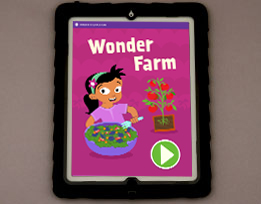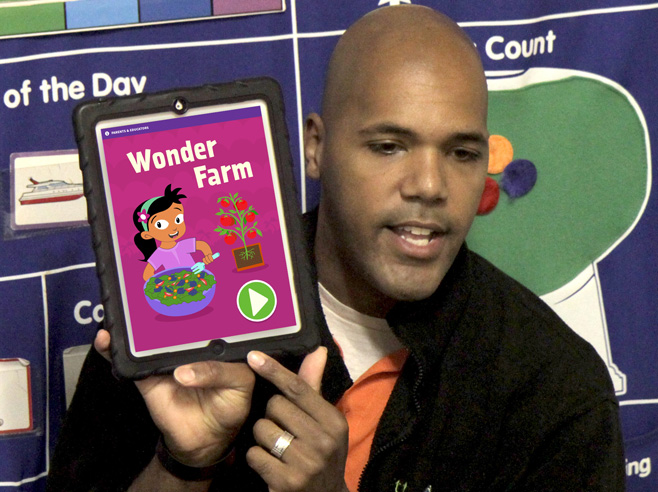Children explore a virtual farm and discover how a balance of light and water helps plants grow. In the Kitchen, they make salad from vegetables that are leaves, stems, roots, and fruits.
Materials

- Wonder Farm app on iPads (2 iPads)
- Projector (if available)
Preparation
- Familiarize yourself with the iPad app Wonder Farm.
Directions: Lesson 2
Circle Time: Introduction
- Tomato Plant. Introduce the digital Wonder Farm game through Shared Play of the introductory Tomato level. This level provides children with only two choices of conditions to provide for the growing plant: water and sunlight.
- Let a child help plant the seed by tapping the seed packet.
- Listen to Nor’s instructions. Restate them if needed. Point out how the dirt fills in to cover the seed, so the seed is ready to grow. Point out the white circles with icons of a watering can and the sun. What do seeds need to grow? Help children identify water and sunlight as things plants need.
- Point out the empty circles along the bottom of the screen. Let’s use the water and the sunlight to see if we can make the seed grow into a big tomato plant. What shall we start out with—some water or some light?
- Let a volunteer drag a white circle of his/her choice into the first circle in the timeline. What could come next? What will help the tomato grow? Some sunlight or more water? Continue to guide children as they fill in all six circles. You may want to count the number of wet and sunny periods so children can think about providing an even balance.
- Note: If available, you may want to connect the iPad to a projector at this point.
- When the six circles in the timeline are all filled, tap the play button. Listen to Nor narrate the events as you watch together. Add your own comments and discussion ideas as well, such as, Look! The tomato seed is sending down a root. What’s growing now? What’s happening to the leaves?
- When the animation is over, have a child touch the purple measurement button to make the measuring strip pop up. Point out how the first number on the strip is next to the part of the stem that is just above the ground. Possible discussion ideas:
- We only measure the parts above the ground. Why do you think that is?
- Together, count the numbers that show how many units tall the tomato plant grew.
- Play the game again.
- If your tomato plant did not grow to the tallest height, discuss what you might do differently to make the plant grow even taller.
- Experiment! What would happen if you provided all light, or all water? Have children predict a result and then try it out.
- Bean Plant. Open Wonder Farm to the Tomato level on one iPad and tap to plant the tomato seed. Open the Bean level on another iPad and tap to plant the bean seed.
- Hold up the two iPads for the class to compare the opening screens of the Tomato level and the Bean level. Ask children how the two screens are different. Draw attention to the different shape and color of the seeds, and the icons in the white circles (Tomato: watering can, sun; Bean: watering can, sun, worm).
- Ask children to recall that sunlight and water are things plants need to grow. How does each plant get sunlight? Water?
- Talk about worms and how they help plants by digging tunnels in the soil so more air and water get to the roots.
- Play the first round of the Bean level, using only water and light to make the bean plant grow. (Use similar game-play guidelines and tips as those used in the Tomato level, above.) On the measuring strip, count the number of units the first bean plant grew to be.
- Play a second round with the bean plant, this time adding worms. Then count the number of units the second bean plant grew to be.
- Which bean plant grew taller, the first one or the second one?
- Did the worms help the plant grow taller? Why do you think so?
- As you watch the animation together, have children raise their hands when they see flowers appearing on the bean plant, and clap their hands when they see beans appear.
Learning Center
- Invite children to explore the Wonder Farm app in pairs or individually. Observe how children approach each level, and use prompts such as those above to engage children in science talk.
- Model examples of science talk and invite children to make predictions about how their choices will affect the plants’ growth. Support children in thinking about cause and effect to get plants to grow to different heights.
- Encourage children to listen to and build on each other’s ideas.
Directions: Lesson 3
Learning Center
- Invite children to explore the Wonder Farm app in pairs or individually. Observe how children approach each level, and use prompts such as those above to engage children in science talk.
- Model examples of science talk and invite children to make predictions about how their choices will affect the plants’ growth. Support children in thinking about cause and effect to get plants to grow to different heights.
- Encourage children to listen to and build on each other’s ideas.
Directions: Lesson 5
Circle Time: Introduction
- Introduce the Carrot level by having the class compare it to the Bean level, with prompts similar to those used in Lesson 2. Note the additional icon of the rabbit.
- After comparing how each plant gets water and sun, remind children that the worm helps the bean plant grow. What do you think the rabbit does to the carrot plant? Do you think the rabbit helps the carrot plant grow or makes it harder for it to grow?
- Play several rounds of the Carrot level, discussing choices; letting volunteers drag pictures of the sun, rain, or rabbit into each circle at the bottom of the screen; measuring the plants; and comparing how tall the plants grow.
Learning Center
- Invite children to explore the Wonder Farm app in pairs or individually. Observe how children approach each level, and use prompts such as those above to engage children in science talk.
- Model examples of science talk and invite children to make predictions about how their choices will affect the plants’ growth. Support children in thinking about cause and effect to get plants to grow to different heights.
- Invite children to describe how they helped each plant grow and compare the growth of plants.
- Encourage children to listen to and build on each other’s ideas.
Directions: Lesson 6
Learning Center
- Invite children to explore the Wonder Farm app in pairs or individually. Note the additional icon of the caterpillar. Ask children what they think a caterpillar does when it finds a nice, tasty cabbage leaf. Will that make it easier or harder for the plant to grow? Observe how children approach each level, and use prompts such as those above to engage children in science talk.
- Model examples of science talk and invite children to make predictions about how their choices will affect the plants’ growth. Support children in thinking about cause and effect to get plants to grow to different heights.
- Encourage children to listen to and build on each other’s ideas.
Directions: Lesson 7
Learning Center
- Invite children to explore the Kitchen activity in the Wonder Farm app in pairs or individually. (Note: The Kitchen activity is the final activity in the app.) Observe how children approach each level, and use prompts such as those above to engage children in science talk.
- Model examples of science talk and invite children to make predictions about how their choices will affect the plants’ growth. Support children in thinking about cause and effect to get plants to grow to different heights.
- Invite children to describe the salads they make. Reinforce vocabulary for the parts of a plant each food item comes from. Possible discussion ideas:
- What plant parts did you choose for your salad?
- Do you have more leaf plants or stem plants in your salad?
- Do you think a tomato is soft or crunchy? What color are the leaves of this cabbage? What color are the tomato leaves?
- Encourage children to listen to and build on each other’s ideas.
Directions: Lessons 11
Learning Center
- Invite children to explore the Wonder Farm app in pairs or individually. Observe how children approach each level, and use prompts such as those above to engage children in science talk.
- Model examples of science talk and invite children to make predictions about how their choices will affect the plants’ growth. Support children in thinking about cause and effect to get plants to grow to different heights.
- Invite children to describe the salads they make. Reinforce vocabulary for the parts of a plant each food item comes from.
- Encourage children to listen to and build on each other’s ideas.


